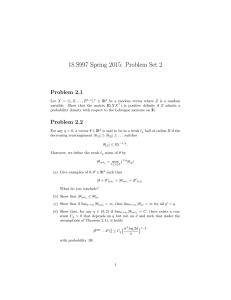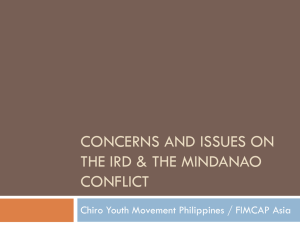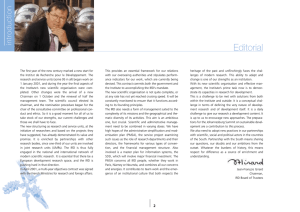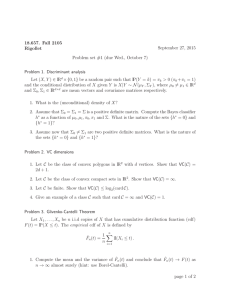Abstracts for the international issue A Le journal de l'IRD
advertisement
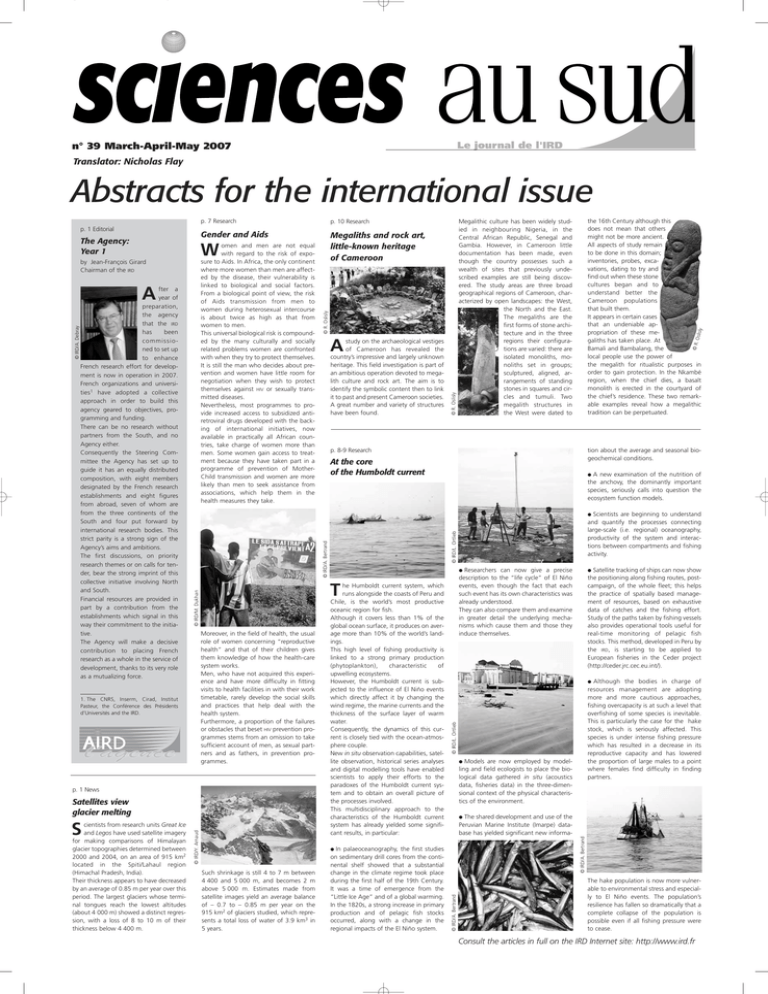
Le journal de l'IRD n° 39 March-April-May 2007 Translator: Nicholas Flay Abstracts for the international issue Megaliths and rock art, little-known heritage of Cameroon A p. 8-9 Research tion about the average and seasonal biogeochemical conditions. At the core of the Humboldt current A new examination of the nutrition of the anchovy, the dominantly important species, seriously calls into question the ecosystem function models. ● Scientists are beginning to understand and quantify the processes connecting large-scale (i.e. regional) oceanography, productivity of the system and interactions between compartments and fishing activity. © IRD/L. Ortlieb © IRD/A. Bertrand Researchers can now give a precise description to the “life cycle” of El Niño events, even though the fact that each such event has its own characteristics was already understood. They can also compare them and examine in greater detail the underlying mechanisms which cause them and those they induce themselves. © IRD/Y. Arnaud Satellites view glacier melting In palaeoceanography, the first studies on sedimentary drill cores from the continental shelf showed that a substantial change in the climate regime took place during the first half of the 19th Century. It was a time of emergence from the “Little Ice Age” and of a global warming. In the 1820s, a strong increase in primary production and of pelagic fish stocks occurred, along with a change in the regional impacts of the El Niño system. ● ● Although the bodies in charge of resources management are adopting more and more cautious approaches, fishing overcapacity is at such a level that overfishing of some species is inevitable. This is particularly the case for the hake stock, which is seriously affected. This species is under intense fishing pressure which has resulted in a decrease in its reproductive capacity and has lowered the proportion of large males to a point where females find difficulty in finding partners. © IRD/L. Ortlieb he Humboldt current system, which runs alongside the coasts of Peru and Chile, is the world’s most productive oceanic region for fish. Although it covers less than 1% of the global ocean surface, it produces on average more than 10% of the world’s landings. This high level of fishing productivity is linked to a strong primary production (phytoplankton), characteristic of upwelling ecosystems. However, the Humboldt current is subjected to the influence of El Niño events which directly affect it by changing the wind regime, the marine currents and the thickness of the surface layer of warm water. Consequently, the dynamics of this current is closely tied with the ocean-atmosphere couple. New in situ observation capabilities, satellite observation, historical series analyses and digital modelling tools have enabled scientists to apply their efforts to the paradoxes of the Humboldt current system and to obtain an overall picture of the processes involved. This multidisciplinary approach to the characteristics of the Humboldt current system has already yielded some significant results, in particular: Models are now employed by modelling and field ecologists to place the biological data gathered in situ (acoustics data, fisheries data) in the three-dimensional context of the physical characteristics of the environment. ● The shared development and use of the Peruvian Marine Institute (Imarpe) database has yielded significant new informa- ● © IRD/A. Bertrand ● Such shrinkage is still 4 to 7 m between 4 400 and 5 000 m, and becomes 2 m above 5 000 m. Estimates made from satellite images yield an average balance of – 0.7 to – 0.85 m per year on the 915 km2 of glaciers studied, which represents a total loss of water of 3.9 km3 in 5 years. Satellite tracking of ships can now show the positioning along fishing routes, postcampaign, of the whole fleet; this helps the practice of spatially based management of resources, based on exhaustive data of catches and the fishing effort. Study of the paths taken by fishing vessels also provides operational tools useful for real-time monitoring of pelagic fish stocks. This method, developed in Peru by the IRD, is starting to be applied to European fisheries in the Ceder project (http://ceder.jrc.cec.eu.int/). ● © IRD/A. Bertrand p. 1 News S study on the archaeological vestiges of Cameroon has revealed the country’s impressive and largely unknown heritage. This field investigation is part of an ambitious operation devoted to megalith culture and rock art. The aim is to identify the symbolic content then to link it to past and present Cameroon societies. A great number and variety of structures have been found. T Moreover, in the field of health, the usual role of women concerning “reproductive health” and that of their children gives them knowledge of how the health-care system works. Men, who have not acquired this experience and have more difficulty in fitting visits to health facilities in with their work timetable, rarely develop the social skills and practices that help deal with the health system. Furthermore, a proportion of the failures or obstacles that beset HIV prevention programmes stems from an omission to take sufficient account of men, as sexual partners and as fathers, in prevention programmes. 1. The CNRS, Inserm, Cirad, Institut Pasteur, the Conférence des Présidents d’Universités and the IRD. cientists from research units Great Ice and Legos have used satellite imagery for making comparisons of Himalayan glacier topographies determined between 2000 and 2004, on an area of 915 km2 located in the Spiti/Lahaul region (Himachal Pradesh, India). Their thickness appears to have decreased by an average of 0.85 m per year over this period. The largest glaciers whose terminal tongues reach the lowest altitudes (about 4 000 m) showed a distinct regression, with a loss of 8 to 10 m of their thickness below 4 400 m. A ● © IRD/M. Dukhan fter a year of preparation, the agency that the IRD has been commissioned to set up to enhance French research effort for development is now in operation in 2007. French organizations and universities1 have adopted a collective approach in order to build this agency geared to objectives, programming and funding. There can be no research without partners from the South, and no Agency either. Consequently the Steering Committee the Agency has set up to guide it has an equally distributed composition, with eight members designated by the French research establishments and eight figures from abroad, seven of whom are from the three continents of the South and four put forward by international research bodies. This strict parity is a strong sign of the Agency’s aims and ambitions. The first discussions, on priority research themes or on calls for tender, bear the strong imprint of this collective initiative involving North and South. Financial resources are provided in part by a contribution from the establishments which signal in this way their commitment to the initiative. The Agency will make a decisive contribution to placing French research as a whole in the service of development, thanks to its very role as a mutualizing force. © R. Oslisly W the 16th Century although this does not mean that others might not be more ancient. All aspects of study remain to be done in this domain; inventories, probes, excavations, dating to try and find out when these stone cultures began and to understand better the Cameroon populations that built them. It appears in certain cases that an undeniable appropriation of these megaliths has taken place. At Bamali and Bambalang, the local people use the power of the megalith for ritualistic purposes in order to gain protection. In the Nkambé region, when the chief dies, a basalt monolith is erected in the courtyard of the chief’s residence. These two remarkable examples reveal how a megalithic tradition can be perpetuated. Megalithic culture has been widely studied in neighbouring Nigeria, in the Central African Republic, Senegal and Gambia. However, in Cameroon little documentation has been made, even though the country possesses such a wealth of sites that previously undescribed examples are still being discovered. The study areas are three broad geographical regions of Cameroon, characterized by open landscapes: the West, the North and the East. The megaliths are the first forms of stone architecture and in the three regions their configurations are varied: there are isolated monoliths, monoliths set in groups; sculptured, aligned, arrangements of standing stones in squares and circles and tumuli. Two megalith structures in the West were dated to Oslis ly Gender and Aids omen and men are not equal with regard to the risk of exposure to Aids. In Africa, the only continent where more women than men are affected by the disease, their vulnerability is linked to biological and social factors. From a biological point of view, the risk of Aids transmission from men to women during heterosexual intercourse is about twice as high as that from women to men. This universal biological risk is compounded by the many culturally and socially related problems women are confronted with when they try to protect themselves. It is still the man who decides about prevention and women have little room for negotiation when they wish to protect themselves against HIV or sexually transmitted diseases. Nevertheless, most programmes to provide increased access to subsidized antiretroviral drugs developed with the backing of international initiatives, now available in practically all African countries, take charge of women more than men. Some women gain access to treatment because they have taken part in a programme of prevention of MotherChild transmission and women are more likely than men to seek assistance from associations, which help them in the health measures they take. by Jean-François Girard Chairman of the IRD © IRD/A. Debray p. 10 Research © R. The Agency: Year 1 p. 7 Research © R. Oslisly p. 1 Editorial The hake population is now more vulnerable to environmental stress and especially to El Niño events. The population’s resilience has fallen so dramatically that a complete collapse of the population is possible even if all fishing pressure were to cease. Consult the articles in full on the IRD Internet site: http://www.ird.fr
